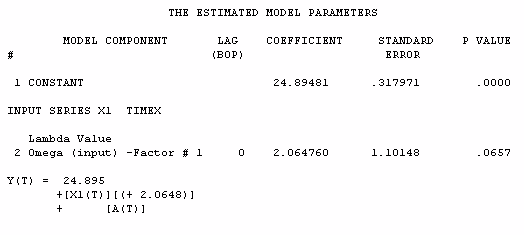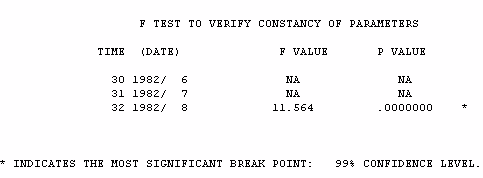SPURIOUS CORRELATION AND IT'S DETECTION
|
A 25% drop in price may not have the same effect now as
it had when the product was first introduced. Statisticians
refer to this as time-varying parameters. Sometimes a
promotion may not have the desired effect consistently thus
an overall assessment might conclude that the promotion
should be discontinued and declared as not having a statistically
significant effect on sales.
|  |
|---|
|
Statisticians are concerned with validating the
assumption that all of the data should be used to estimate
parameters. Sometimes, we have too much data. The natural
question is: Can we test for changes in parameters or model
form over time allowing us to conclude that the most recent
data should not be mixed or contaminated by using older data?
(Chow's Test)
|  |
|---|
|
Consider the case of sales for the last 60 months and the
knowledge that a promotion was put on at five points in time, viz.
t=16,24,32,46 and 59 . Here we show a plot of the two series.
|  |
|---|
|
Standard regression modelling leads to the conclusion that
the indicator variable, month of promotion, is not statistically
significant.
|  |
|---|
|
However, if we employ a test to determine if the
parameters of the model have changed over time, we find that there has been a significant change.
The test results indicate
that the first 31 observations should be treated
independently from the last or more recent 29. This means
that we have found a statistically significant difference in
the parameters over time. The conclusion is that we should only use the
most recent 29 observations.
|  |
|---|
|
Estimating the model using the most recent 29 values
leads to a different conclusion with respect to the promotion variable.
|  |
|---|
|
If we closely examine the overall sales history and highlight
the points of promotion, we can see these results. Notice how
the first two points of promotion (t=16 and 24) show no
apparent response while the opposite is true for t=32,46 and 59.
|  |
|---|
|
Statistical techniques are a very powerful way of discovering
regularities, but one has to be constantly aware of the assumptions
and use methodologies that aggressively test these assumptions.
|  |
|---|
|
The data.
|  |
|---|
CLICK HERE:Home Page For AUTOBOX






